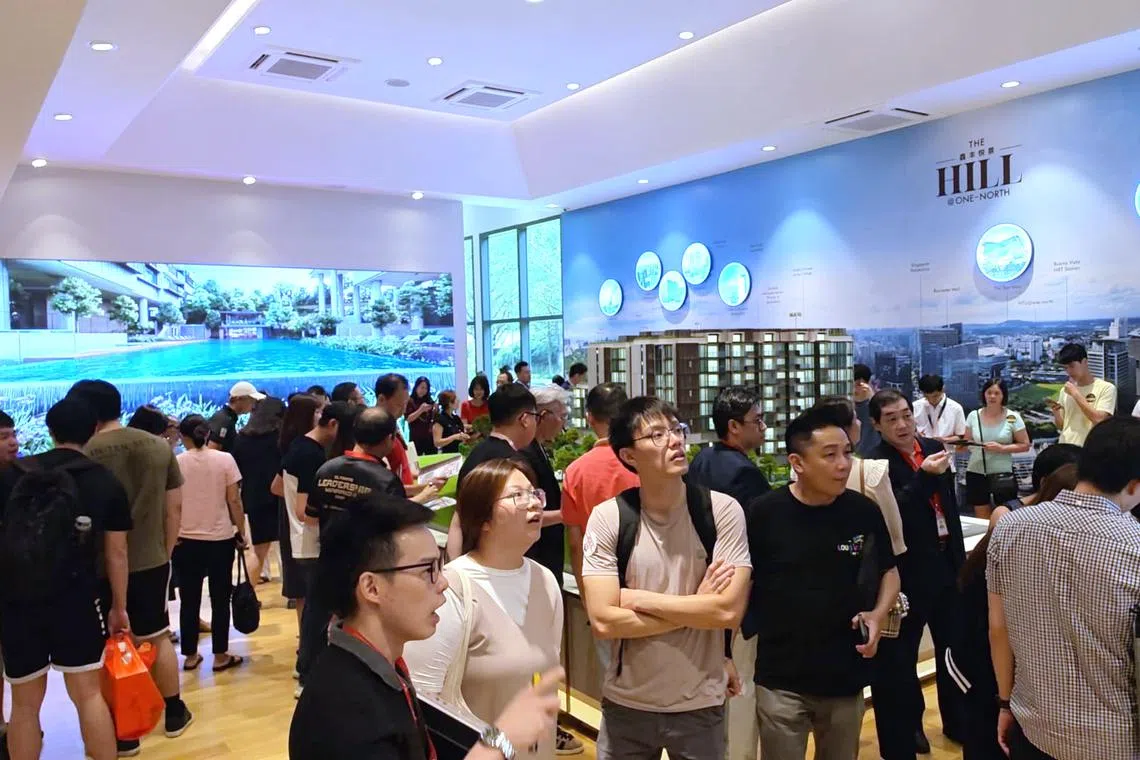Private home prices flatten further in Q2 on lower sales, more buyer resistance
Sign up now: Get ST's newsletters delivered to your inbox

At the launch of The Hill @ One-North, 43 units were sold at an average price of $2,595 per sq ft.
PHOTO: KINGSFORD REAL ESTATE DEVELOPMENT PTE LTD
Follow topic:
SINGAPORE - The private residential market continued to moderate in the second quarter, with overall prices rising at a slower clip, as new home sales fell and buyers’ resistance to high prices increased.
Private residential property prices rose 0.9 per cent in the second quarter, according to Urban Redevelopment Authority (URA) data released on July 26. This is below flash estimates of 1.1 per cent growth and down from 1.4 per cent growth in the first quarter.
Just 634 uncompleted private homes, excluding executive condominiums, were launched for sale in the second quarter, compared with 1,304 units in the previous quarter, as developers held back launches in the face of tentative buying sentiment and economic uncertainty.
For the first half of 2024, overall private residential sales volume fell by 3.8 per cent to 9,145 units from 9,509 units in the first half of 2023 – the lowest semi-annual volume recorded since 6,933 units were sold at the height of the Covid-19 pandemic in the first half of 2020.
Buyers have become more price-sensitive in the face of an ample pipeline of new launches, current loan curbs and still-high interest rates amid a slowing jobs market, analysts say.
On a quarterly basis, new private home sales volume fell 37.7 per cent to 725 units in the second quarter, from 1,164 units in the previous quarter.
From January to June 2024, developers’ sales fell to a new record low of 1,889 units, compared with a previous low of 1,977 units during the global financial crisis in the second half of 2008.
But the key difference is that the secondary market held up in the second quarter of 2024, as the price gap between new home prices and resale prices widened, prompting bargain hunters to switch to resales and sub-sales, CBRE’s head of research for South-east Asia Tricia Song said.
A sub-sale is recorded when a buyer resells a property bought directly from a developer, before a project is completed.
Resale transactions jumped 41.4 per cent to 3,802 units in the second quarter of 2024, while sub-sales rose 2.9 per cent to 388 units.
In contrast, property prices, developers’ sales and secondary volumes all plummeted when the property bubble burst in 2008, Ms Song said.
Mr Ismail Gafoor, chief executive of PropNex, noted that the resale segment accounted for a record high of 77.4 per cent of overall private home sales in the second quarter.
“We expect the resale market to drive private home sales this year, and project that 12,000 to 13,000 resale private homes could be transacted in 2024,” he said.
Cushman & Wakefield head of research Wong Xian Yang noted that although the take-up rate of new launches is slowing down, those that are priced attractively continue to see healthy sales.
“The performance of major launches (100 units and above) has slowed, with only one out of six major projects launched between January and June 2024 selling more than half of its stock in the first launch month. In comparison, four out of seven major new launches sold more than half of their stock within their launch month in the first half of 2023,” Mr Wong said.
Analysts believe that overall private home sales should pick up in the second half of 2024, should interest rate cuts materialise and as several major new launches hit the market.
Landed home prices rose 1.9 per cent in the second quarter after a 2.6 per cent increase in the preceding quarter. Non-landed home prices gained 0.6 per cent in the second quarter, down from 1 per cent growth in the previous quarter.
The city fringe non-landed market outperformed the other two submarkets with a price growth of 1.6 per cent in the second quarter, compared with a 0.3 per cent gain in the previous quarter.
This could be due to the launch of The Hill @ One-North, where 43 units were sold at an average price of $2,595 per sq ft over its launch weekend,
In contrast, non-landed home prices in the prime district fell 0.3 per cent in the second quarter, compared with a 3.4 per cent gain in the first quarter, due to a lack of major new launches and as foreign buyers remain sidelined by the 60 per cent additional buyer’s stamp duty.
Suburban prices were up 0.2 per cent, similar to the previous quarter, despite underlying demand from HDB upgraders and a faster quarterly rise of 2.3 per cent in the HDB resale price index in the second quarter, Ms Chia noted.
Prices in the suburbs may be reaching a limit after a surge of 13.7 per cent in 2023, compared with a growth of 1.9 per cent in the prime district and 3.1 per cent in the city fringe last year, she said.
Meanwhile, private home rentals continued to slow, with the URA’s overall rental index for private homes dipping by 0.8 per cent quarter on quarter in the second quarter, following a 1.9 per cent drop in the previous quarter. This is in stark contrast to the annual increase of 8.7 per cent in 2023 and the 29.7 per cent gain in 2022.
“A broad-based decline in rents was recorded across all non-landed residential segments, with the city fringe market seeing the steepest fall of 1.4 per cent quarter on quarter, followed by a 1.3 per cent drop in the suburbs and a 0.1 per cent dip in the prime district,” Mr Wong noted.
CBRE’s Ms Song noted that with more new private home completions expected for the rest of 2024, rents may continue to ease in the second half.
“More pressure would likely be observed in the city fringe and the prime district, which account for 43 per cent and 33 per cent of new home completions, respectively, in the second half of 2024,” she added.
But rents are not likely to drop to pre-2022 levels, due to increased property taxes, higher home prices and mortgage payments, as well as demand from private home downgraders who are subject to a 15-month wait-out period before they can buy non-subsidised resale flats, she said.


